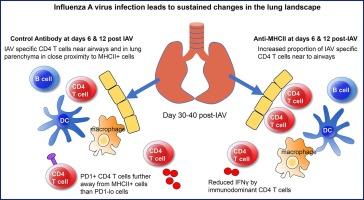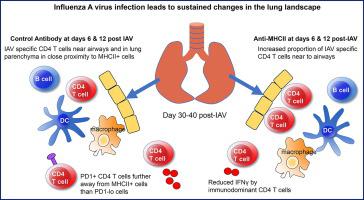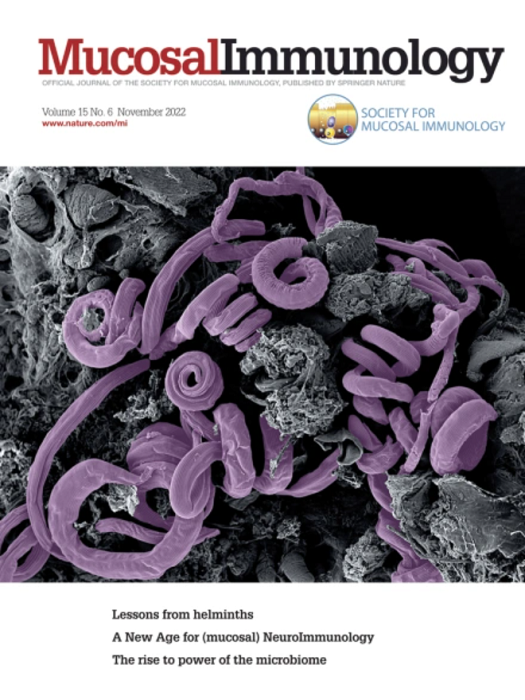肺部流感病毒特异性记忆 CD4 T 细胞的位置和最佳细胞因子的产生取决于与肺部抗原呈递细胞的相互作用。
IF 7.9
2区 医学
Q1 IMMUNOLOGY
引用次数: 0
摘要
甲型流感病毒(IAV)感染会导致粘膜记忆 CD4 T 细胞的形成,从而保护宿主。要想设计出更有效的疫苗,就必须深入了解影响记忆细胞发育的信号。我们研究了小鼠感染 IAV 后肺部记忆性 CD4 T 细胞的形成,分析了肺部结构和免疫细胞组成的变化。在原发和记忆时间点,整个肺部都发现了 IAV 特异性 CD4 T 细胞。这些细胞出现在肺部气道附近,并与一系列免疫细胞(包括巨噬细胞、树突状细胞和 B 细胞)密切接触。肺部 IAV 特异性 CD4 T 细胞和 MHCII+ 细胞在原发性免疫反应期间的相互作用对形成随后的记忆库非常重要。用抗MHCII阻断抗体治疗可增加肺气管中发现的记忆性CD4 T细胞的比例,但会降低IAV特异性免疫显性记忆性CD4 T细胞的干扰素-γ表达。免疫优势 CD4 T 细胞比其他 IAV 特异性 CD4 T 细胞表达更高水平的 PD1,PD1+ 记忆 CD4 T 细胞比 PD1 低的记忆 CD4 T 细胞远离 MHCII+ 细胞。在使用抗 MHCII 抗体治疗的小鼠中,这种位置上的差异消失了。这些数据表明,肺部持续的抗原呈递通过调节细胞因子的产生和位置影响了记忆性 CD4 T 细胞的形成。本文章由计算机程序翻译,如有差异,请以英文原文为准。


Lung influenza virus-specific memory CD4 T cell location and optimal cytokine production are dependent on interactions with lung antigen-presenting cells
Influenza A virus (IAV) infection leads to the formation of mucosal memory CD4 T cells that can protect the host. An in-depth understanding of the signals that shape memory cell development is required for more effective vaccine design. We have examined the formation of memory CD4 T cells in the lung following IAV infection of mice, characterizing changes to the lung landscape and immune cell composition. IAV-specific CD4 T cells were found throughout the lung at both primary and memory time points. These cells were found near lung airways and in close contact with a range of immune cells including macrophages, dendritic cells, and B cells. Interactions between lung IAV-specific CD4 T cells and major histocompatibility complex (MHC)II+ cells during the primary immune response were important in shaping the subsequent memory pool. Treatment with an anti-MHCII blocking antibody increased the proportion of memory CD4 T cells found in lung airways but reduced interferon-γ expression by IAV-specific immunodominant memory CD4 T cells. The immunodominant CD4 T cells expressed higher levels of programmed death ligand 1 (PD1) than other IAV-specific CD4 T cells and PD1+ memory CD4 T cells were located further away from MHCII+ cells than their PD1-low counterparts. This distinction in location was lost in mice treated with anti-MHCII antibodies. These data suggest that sustained antigen presentation in the lung impacts the formation of memory CD4 T cells by regulating their cytokine production and location.
求助全文
通过发布文献求助,成功后即可免费获取论文全文。
去求助
来源期刊

Mucosal Immunology
医学-免疫学
CiteScore
16.60
自引率
3.80%
发文量
100
审稿时长
12 days
期刊介绍:
Mucosal Immunology, the official publication of the Society of Mucosal Immunology (SMI), serves as a forum for both basic and clinical scientists to discuss immunity and inflammation involving mucosal tissues. It covers gastrointestinal, pulmonary, nasopharyngeal, oral, ocular, and genitourinary immunology through original research articles, scholarly reviews, commentaries, editorials, and letters. The journal gives equal consideration to basic, translational, and clinical studies and also serves as a primary communication channel for the SMI governing board and its members, featuring society news, meeting announcements, policy discussions, and job/training opportunities advertisements.
 求助内容:
求助内容: 应助结果提醒方式:
应助结果提醒方式:


